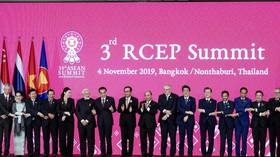India should join China-backed trade bloc – government official

India should consider joining the 15-member Regional Comprehensive Economic Partnership (RCEP), a senior official from an Indian government think tank suggested on Thursday, according to Reuters.
New Delhi opted out of the RCEP trade deal negotiations in 2019, citing the risk of trade imbalance, as China is seen as the main backer of the bloc.
B.V.R. Subrahmanyam, the CEO of the NITI Aayog public policy think tank, suggested that India should now become part of the RCEP, as well as another regional trade pact, the Comprehensive and Progressive Agreement for Trans-Pacific Partnership (CPTPP). The latter was initially backed by the US but Washington withdrew from it in 2017 during the first presidency of Donald Trump.
Joining these trade blocs could significantly enhance India’s manufacturing sector and boost exports from small- and medium-sized enterprises, which account for 40% of the country’s total exports, Subrahmanyam argued, according to Reuters.
The RCEP, which is regarded as the world’s largest free-trade deal, currently comprises ten countries from the Association of Southeast Asian Nations (ASEAN) – Australia, China, Korea, Japan, and New Zealand.
Negotiations on the deal began during the 21st ASEAN summit in Cambodia in November 2012 and the deal was finally signed in 2022. The RCEP aims to remove tariffs on at least 90% of the goods traded among member countries over a period of 20 years.
The CPTPP is a free-trade agreement involving 11 nations, including Australia, Canada, Chile, Japan, Malaysia, Mexico, New Zealand, and Singapore. It was signed in March 2018 and implemented the following December.
Subrahmanyam said India had not fully capitalized on global companies relocating factories outside China due to high tariffs. “I don’t think we have captured the China Plus One opportunity as much as we could have,” he remarked, adding that countries like Vietnam, Indonesia, Malaysia, Turkey, and Mexico had likely benefited more from this trend than India.
The development comes just weeks after India’s commerce minister rejected the notion of joining the RCEP, claiming that it was not in the country’s interests to enter a free-trade agreement with China.
“India will not join the RCEP because it does not align with the foundational principles of ASEAN, and entering a free-trade agreement with China is not beneficial for our nation,” said Piyush Goyal in an interview with CNBC in September. Goyal highlighted that India already had free-trade agreements with ASEAN, Japan, and South Korea, along with a $300 million bilateral trade relationship with New Zealand.
India’s trade cooperation with China has been complicated since a border standoff in 2020, which impacted overall bilateral ties. Last month, however, the two neighbors agreed a de-escalation along the Line of Actual Control (LAC) – the 3,500km (approximately 2,100-mile) border between the two countries. The announcement was made on the eve of a BRICS summit in Kazan, Russia, where leaders Narendra Modi and Xi Jinping held their first bilateral meeting in nearly five years. They welcomed the agreement on complete disengagement and resolution of issues.













